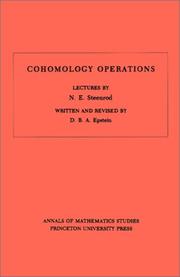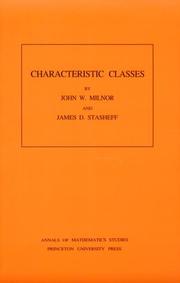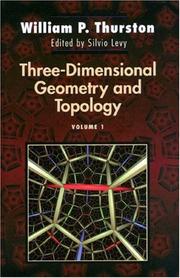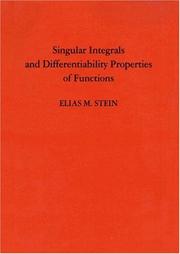| Listing 1 - 7 of 7 |
Sort by
|

ISBN: 0691079242 1400881676 Year: 2016 Publisher: Princeton, NJ : Princeton University Press,
Abstract | Keywords | Export | Availability | Bookmark
 Loading...
Loading...Choose an application
- Reference Manager
- EndNote
- RefWorks (Direct export to RefWorks)
Written and revised by D. B. A. Epstein.
Category theory. Homological algebra --- 515.14 --- Algebraic topology --- Homology theory. --- 515.14 Algebraic topology --- Cohomology theory --- Contrahomology theory --- Algebra homomorphism. --- Algebra over a field. --- Algebraic structure. --- Approximation. --- Axiom. --- Basis (linear algebra). --- CW complex. --- Cartesian product. --- Classical group. --- Coefficient. --- Cohomology operation. --- Cohomology ring. --- Cohomology. --- Commutative property. --- Complex number. --- Computation. --- Continuous function. --- Cup product. --- Cyclic group. --- Diagram (category theory). --- Dimension. --- Direct limit. --- Embedding. --- Existence theorem. --- Fibration. --- Homomorphism. --- Hopf algebra. --- Hopf invariant. --- Ideal (ring theory). --- Integer. --- Inverse limit. --- Manifold. --- Mathematics. --- Monomial. --- N-skeleton. --- Natural transformation. --- Permutation. --- Quaternion. --- Ring (mathematics). --- Scalar (physics). --- Special unitary group. --- Steenrod algebra. --- Stiefel manifold. --- Subgroup. --- Subset. --- Summation. --- Symmetric group. --- Symplectic group. --- Theorem. --- Uniqueness theorem. --- Upper and lower bounds. --- Vector field. --- Vector space. --- W0.

ISBN: 0691081220 9780691081229 140088182X Year: 1974 Volume: 76 Publisher: Princeton : Princeton University Press,
Abstract | Keywords | Export | Availability | Bookmark
 Loading...
Loading...Choose an application
- Reference Manager
- EndNote
- RefWorks (Direct export to RefWorks)
The theory of characteristic classes provides a meeting ground for the various disciplines of differential topology, differential and algebraic geometry, cohomology, and fiber bundle theory. As such, it is a fundamental and an essential tool in the study of differentiable manifolds.In this volume, the authors provide a thorough introduction to characteristic classes, with detailed studies of Stiefel-Whitney classes, Chern classes, Pontrjagin classes, and the Euler class. Three appendices cover the basics of cohomology theory and the differential forms approach to characteristic classes, and provide an account of Bernoulli numbers.Based on lecture notes of John Milnor, which first appeared at Princeton University in 1957 and have been widely studied by graduate students of topology ever since, this published version has been completely revised and corrected.
Algebraic topology --- Characteristic classes --- Classes caractéristiques --- 515.16 --- #WWIS:d.d. Prof. L. Bouckaert/ALTO --- Classes, Characteristic --- Differential topology --- Topology of manifolds --- Characteristic classes. --- 515.16 Topology of manifolds --- Classes caractéristiques --- Additive group. --- Axiom. --- Basis (linear algebra). --- Boundary (topology). --- Bundle map. --- CW complex. --- Canonical map. --- Cap product. --- Cartesian product. --- Characteristic class. --- Charles Ehresmann. --- Chern class. --- Classifying space. --- Coefficient. --- Cohomology ring. --- Cohomology. --- Compact space. --- Complex dimension. --- Complex manifold. --- Complex vector bundle. --- Complexification. --- Computation. --- Conformal geometry. --- Continuous function. --- Coordinate space. --- Cross product. --- De Rham cohomology. --- Diffeomorphism. --- Differentiable manifold. --- Differential form. --- Differential operator. --- Dimension (vector space). --- Dimension. --- Direct sum. --- Directional derivative. --- Eilenberg–Steenrod axioms. --- Embedding. --- Equivalence class. --- Euler class. --- Euler number. --- Existence theorem. --- Existential quantification. --- Exterior (topology). --- Fiber bundle. --- Fundamental class. --- Fundamental group. --- General linear group. --- Grassmannian. --- Gysin sequence. --- Hausdorff space. --- Homeomorphism. --- Homology (mathematics). --- Homotopy. --- Identity element. --- Integer. --- Interior (topology). --- Isomorphism class. --- J-homomorphism. --- K-theory. --- Leibniz integral rule. --- Levi-Civita connection. --- Limit of a sequence. --- Linear map. --- Metric space. --- Natural number. --- Natural topology. --- Neighbourhood (mathematics). --- Normal bundle. --- Open set. --- Orthogonal complement. --- Orthogonal group. --- Orthonormal basis. --- Partition of unity. --- Permutation. --- Polynomial. --- Power series. --- Principal ideal domain. --- Projection (mathematics). --- Representation ring. --- Riemannian manifold. --- Sequence. --- Singular homology. --- Smoothness. --- Special case. --- Steenrod algebra. --- Stiefel–Whitney class. --- Subgroup. --- Subset. --- Symmetric function. --- Tangent bundle. --- Tensor product. --- Theorem. --- Thom space. --- Topological space. --- Topology. --- Unit disk. --- Unit vector. --- Variable (mathematics). --- Vector bundle. --- Vector space. --- Topologie differentielle --- Classes caracteristiques --- Classes et nombres caracteristiques

ISBN: 0691086869 0691086850 1400837219 1322063214 9781400837212 9780691086866 9780691086859 Year: 2001 Volume: 148 Publisher: Princeton, New Jersey : Princeton University Press,
Abstract | Keywords | Export | Availability | Bookmark
 Loading...
Loading...Choose an application
- Reference Manager
- EndNote
- RefWorks (Direct export to RefWorks)
The first two chapters of this book offer a modern, self-contained exposition of the elementary theory of triangulated categories and their "ients. The simple, elegant presentation of these known results makes these chapters eminently suitable as a text for graduate students. The remainder of the book is devoted to new research, providing, among other material, some remarkable improvements on Brown's classical representability theorem. In addition, the author introduces a class of triangulated categories"--the "well generated triangulated categories"--and studies their properties. This exercise is particularly worthwhile in that many examples of triangulated categories are well generated, and the book proves several powerful theorems for this broad class. These chapters will interest researchers in the fields of algebra, algebraic geometry, homotopy theory, and mathematical physics.
Categories (Mathematics). --- Category theory. Homological algebra --- Categories (Mathematics) --- 512.58 --- 512.58 Categories. Category theory --- Categories. Category theory --- Category theory (Mathematics) --- Algebra, Homological --- Algebra, Universal --- Group theory --- Logic, Symbolic and mathematical --- Topology --- Functor theory --- Abelian category. --- Abelian group. --- Additive category. --- Adjoint functors. --- Adjoint. --- Adjunction (field theory). --- Associative property. --- Axiom. --- Basis (linear algebra). --- Bijection. --- Biproduct. --- Brown's representability theorem. --- Cardinal number. --- Cardinality. --- Category of abelian groups. --- Chain complex. --- Class (set theory). --- Cohomology. --- Computation. --- Coproduct. --- Corollary. --- Countable set. --- Counterexample. --- Derived category. --- Derived functor. --- Diagram (category theory). --- Direct limit. --- Direct sum. --- Discrete valuation ring. --- Duality (mathematics). --- Embedding. --- Equivalence class. --- Equivalence of categories. --- Exact functor. --- Exact sequence. --- Existence theorem. --- Existential quantification. --- Factorization. --- Finitely generated abelian group. --- Functor category. --- Functor. --- Grothendieck category. --- Grothendieck's Tôhoku paper. --- Group homomorphism. --- Homological algebra. --- Homotopy category of chain complexes. --- Homotopy category. --- Homotopy colimit. --- Homotopy. --- I0. --- Injective function. --- Injective object. --- Integer. --- Isomorph. --- Isomorphism class. --- Jack Morava. --- K-theory. --- Limit (category theory). --- Limit of a sequence. --- Limit ordinal. --- Linear map. --- Mapping cone (homological algebra). --- Mathematical induction. --- Maximal ideal. --- Module (mathematics). --- Monomorphism. --- Moore space. --- Morphism. --- N0. --- Natural transformation. --- Open set. --- Partially ordered set. --- Pierre Deligne. --- Prime number. --- Projective object. --- Proportionality (mathematics). --- Quotient category. --- Regular cardinal. --- Representable functor. --- Sheaf (mathematics). --- Special case. --- Spectral sequence. --- Subcategory. --- Subobject. --- Subsequence. --- Subset. --- Successor ordinal. --- Summation. --- Tautology (logic). --- Tensor product. --- Theorem. --- Theory. --- Topological group. --- Transfinite induction. --- Transfinite. --- Triangulated category. --- Universal property. --- Vector space. --- Vladimir Voevodsky. --- Yoneda lemma.
Book
ISBN: 0691080135 1400869226 Year: 1977 Publisher: Princeton : Princeton University Press,
Abstract | Keywords | Export | Availability | Bookmark
 Loading...
Loading...Choose an application
- Reference Manager
- EndNote
- RefWorks (Direct export to RefWorks)
The ∂̄ Neumann problem is probably the most important and natural example of a non-elliptic boundary value problem, arising as it does from the Cauchy-Riemann equations. It has been known for some time how to prove solvability and regularity by the use of L2 methods. In this monograph the authors apply recent methods involving the Heisenberg group to obtain parametricies and to give sharp estimates in various function spaces, leading to a better understanding of the ∂̄ Neumann problem. The authors have added substantial background material to make the monograph more accessible to students.Originally published in 1977.The Princeton Legacy Library uses the latest print-on-demand technology to again make available previously out-of-print books from the distinguished backlist of Princeton University Press. These editions preserve the original texts of these important books while presenting them in durable paperback and hardcover editions. The goal of the Princeton Legacy Library is to vastly increase access to the rich scholarly heritage found in the thousands of books published by Princeton University Press since its founding in 1905.
Partial differential equations --- Neumann problem. --- Neumann problem --- Mathematics --- Physical Sciences & Mathematics --- Calculus --- Boundary value problems --- Differential equations, Partial --- A priori estimate. --- Abuse of notation. --- Analytic continuation. --- Analytic function. --- Approximation. --- Asymptotic expansion. --- Asymptotic formula. --- Basis (linear algebra). --- Besov space. --- Boundary (topology). --- Boundary value problem. --- Boundedness. --- Calculation. --- Cauchy's integral formula. --- Cauchy–Riemann equations. --- Change of variables. --- Characterization (mathematics). --- Combination. --- Commutative property. --- Commutator. --- Complex analysis. --- Complex manifold. --- Complex number. --- Computation. --- Convolution. --- Coordinate system. --- Corollary. --- Counterexample. --- Derivative. --- Determinant. --- Differential equation. --- Dimension (vector space). --- Dimension. --- Dimensional analysis. --- Dirichlet boundary condition. --- Eigenvalues and eigenvectors. --- Elliptic boundary value problem. --- Equation. --- Error term. --- Estimation. --- Even and odd functions. --- Existential quantification. --- Function space. --- Fundamental solution. --- Green's theorem. --- Half-space (geometry). --- Hardy's inequality. --- Heisenberg group. --- Holomorphic function. --- Infimum and supremum. --- Integer. --- Integral curve. --- Integral expression. --- Inverse function. --- Invertible matrix. --- Iteration. --- Laplace's equation. --- Left inverse. --- Lie algebra. --- Lie group. --- Linear combination. --- Logarithm. --- Lp space. --- Mathematical induction. --- Neumann boundary condition. --- Notation. --- Open problem. --- Orthogonal complement. --- Orthogonality. --- Parametrix. --- Partial derivative. --- Pointwise. --- Polynomial. --- Principal branch. --- Principal part. --- Projection (linear algebra). --- Pseudo-differential operator. --- Quantity. --- Recursive definition. --- Schwartz space. --- Scientific notation. --- Second derivative. --- Self-adjoint. --- Singular value. --- Sobolev space. --- Special case. --- Standard basis. --- Stein manifold. --- Subgroup. --- Subset. --- Summation. --- Support (mathematics). --- Tangent bundle. --- Theorem. --- Theory. --- Upper half-plane. --- Variable (mathematics). --- Vector field. --- Volume element. --- Weak solution. --- Neumann, Problème de --- Equations aux derivees partielles --- Problemes aux limites

ISBN: 0691081018 9780691081014 140088179X 9781400881796 Year: 1971 Volume: 72 Publisher: Princeton : Princeton University Press,
Abstract | Keywords | Export | Availability | Bookmark
 Loading...
Loading...Choose an application
- Reference Manager
- EndNote
- RefWorks (Direct export to RefWorks)
Algebraic K-theory describes a branch of algebra that centers about two functors. K0 and K1, which assign to each associative ring ∧ an abelian group K0∧ or K1∧ respectively. Professor Milnor sets out, in the present work, to define and study an analogous functor K2, also from associative rings to abelian groups. Just as functors K0 and K1 are important to geometric topologists, K2 is now considered to have similar topological applications. The exposition includes, besides K-theory, a considerable amount of related arithmetic.
Algebraic geometry --- Ordered algebraic structures --- Associative rings --- Abelian groups --- Functor theory --- Anneaux associatifs --- Groupes abéliens --- Foncteurs, Théorie des --- 512.73 --- 515.14 --- Functorial representation --- Algebra, Homological --- Categories (Mathematics) --- Functional analysis --- Transformations (Mathematics) --- Commutative groups --- Group theory --- Rings (Algebra) --- Cohomology theory of algebraic varieties and schemes --- Algebraic topology --- Abelian groups. --- Associative rings. --- Functor theory. --- 515.14 Algebraic topology --- 512.73 Cohomology theory of algebraic varieties and schemes --- Groupes abéliens --- Foncteurs, Théorie des --- Abelian group. --- Absolute value. --- Addition. --- Algebraic K-theory. --- Algebraic equation. --- Algebraic integer. --- Banach algebra. --- Basis (linear algebra). --- Big O notation. --- Circle group. --- Coefficient. --- Commutative property. --- Commutative ring. --- Commutator. --- Complex number. --- Computation. --- Congruence subgroup. --- Coprime integers. --- Cyclic group. --- Dedekind domain. --- Direct limit. --- Direct proof. --- Direct sum. --- Discrete valuation. --- Division algebra. --- Division ring. --- Elementary matrix. --- Elliptic function. --- Exact sequence. --- Existential quantification. --- Exterior algebra. --- Factorization. --- Finite group. --- Free abelian group. --- Function (mathematics). --- Fundamental group. --- Galois extension. --- Galois group. --- General linear group. --- Group extension. --- Hausdorff space. --- Homological algebra. --- Homomorphism. --- Homotopy. --- Ideal (ring theory). --- Ideal class group. --- Identity element. --- Identity matrix. --- Integral domain. --- Invertible matrix. --- Isomorphism class. --- K-theory. --- Kummer theory. --- Lattice (group). --- Left inverse. --- Local field. --- Local ring. --- Mathematics. --- Matsumoto's theorem. --- Maximal ideal. --- Meromorphic function. --- Monomial. --- Natural number. --- Noetherian. --- Normal subgroup. --- Number theory. --- Open set. --- Picard group. --- Polynomial. --- Prime element. --- Prime ideal. --- Projective module. --- Quadratic form. --- Quaternion. --- Quotient ring. --- Rational number. --- Real number. --- Right inverse. --- Ring of integers. --- Root of unity. --- Schur multiplier. --- Scientific notation. --- Simple algebra. --- Special case. --- Special linear group. --- Subgroup. --- Summation. --- Surjective function. --- Tensor product. --- Theorem. --- Topological K-theory. --- Topological group. --- Topological space. --- Topology. --- Torsion group. --- Variable (mathematics). --- Vector space. --- Wedderburn's theorem. --- Weierstrass function. --- Whitehead torsion. --- K-théorie

ISBN: 0691083045 1400865328 9780691083049 Year: 1997 Volume: 35. Publisher: Princeton : Princeton University Press,
Abstract | Keywords | Export | Availability | Bookmark
 Loading...
Loading...Choose an application
- Reference Manager
- EndNote
- RefWorks (Direct export to RefWorks)
This book develops some of the extraordinary richness, beauty, and power of geometry in two and three dimensions, and the strong connection of geometry with topology. Hyperbolic geometry is the star. A strong effort has been made to convey not just denatured formal reasoning (definitions, theorems, and proofs), but a living feeling for the subject. There are many figures, examples, and exercises of varying difficulty. This book was the origin of a grand scheme developed by Thurston that is now coming to fruition. In the 1920s and 1930s the mathematics of two-dimensional spaces was formalized. It was Thurston's goal to do the same for three-dimensional spaces. To do this, he had to establish the strong connection of geometry to topology--the study of qualitative questions about geometrical structures. The author created a new set of concepts, and the expression "Thurston-type geometry" has become a commonplace. Three-Dimensional Geometry and Topology had its origins in the form of notes for a graduate course the author taught at Princeton University between 1978 and 1980. Thurston shared his notes, duplicating and sending them to whoever requested them. Eventually, the mailing list grew to more than one thousand names. The book is the culmination of two decades of research and has become the most important and influential text in the field. Its content also provided the methods needed to solve one of mathematics' oldest unsolved problems--the Poincaré Conjecture. In 2005 Thurston won the first AMS Book Prize, for Three-dimensional Geometry and Topology. The prize recognizes an outstanding research book that makes a seminal contribution to the research literature. Thurston received the Fields Medal, the mathematical equivalent of the Nobel Prize, in 1982 for the depth and originality of his contributions to mathematics. In 1979 he was awarded the Alan T. Waterman Award, which recognizes an outstanding young researcher in any field of science or engineering supported by the National Science Foundation.
Topology --- Differential geometry. Global analysis --- Geometry, Hyperbolic --- Three-manifolds (Topology) --- Géométrie hyperbolique --- Variétés topologiques à 3 dimensions --- Geometry, Hyperbolic. --- 514.1 --- 3-manifolds (Topology) --- Manifolds, Three dimensional (Topology) --- Three-dimensional manifolds (Topology) --- Low-dimensional topology --- Topological manifolds --- Hyperbolic geometry --- Lobachevski geometry --- Lobatschevski geometry --- Geometry, Non-Euclidean --- General geometry --- Three-manifolds (Topology). --- 514.1 General geometry --- Géométrie hyperbolique --- Variétés topologiques à 3 dimensions --- 3-sphere. --- Abelian group. --- Affine space. --- Affine transformation. --- Atlas (topology). --- Automorphism. --- Basis (linear algebra). --- Bounded set (topological vector space). --- Brouwer fixed-point theorem. --- Cartesian coordinate system. --- Characterization (mathematics). --- Compactification (mathematics). --- Conformal map. --- Contact geometry. --- Curvature. --- Cut locus (Riemannian manifold). --- Diagram (category theory). --- Diffeomorphism. --- Differentiable manifold. --- Dimension (vector space). --- Dimension. --- Disk (mathematics). --- Divisor (algebraic geometry). --- Dodecahedron. --- Eigenvalues and eigenvectors. --- Embedding. --- Euclidean space. --- Euler number. --- Exterior (topology). --- Facet (geometry). --- Fiber bundle. --- Foliation. --- Fundamental group. --- Gaussian curvature. --- Geometry. --- Group homomorphism. --- Half-space (geometry). --- Holonomy. --- Homeomorphism. --- Homotopy. --- Horocycle. --- Hyperbolic geometry. --- Hyperbolic manifold. --- Hyperbolic space. --- Hyperboloid model. --- Interior (topology). --- Intersection (set theory). --- Isometry group. --- Isometry. --- Jordan curve theorem. --- Lefschetz fixed-point theorem. --- Lie algebra. --- Lie group. --- Line (geometry). --- Linear map. --- Linearization. --- Manifold. --- Mathematical induction. --- Metric space. --- Moduli space. --- Möbius transformation. --- Norm (mathematics). --- Pair of pants (mathematics). --- Piecewise linear manifold. --- Piecewise linear. --- Poincaré disk model. --- Polyhedron. --- Projection (linear algebra). --- Projection (mathematics). --- Pseudogroup. --- Pullback (category theory). --- Quasi-isometry. --- Quotient space (topology). --- Riemann mapping theorem. --- Riemann surface. --- Riemannian manifold. --- Sheaf (mathematics). --- Sign (mathematics). --- Simplicial complex. --- Simply connected space. --- Special linear group. --- Stokes' theorem. --- Subgroup. --- Subset. --- Tangent space. --- Tangent vector. --- Tetrahedron. --- Theorem. --- Three-dimensional space (mathematics). --- Topological group. --- Topological manifold. --- Topological space. --- Topology. --- Transversal (geometry). --- Two-dimensional space. --- Uniformization theorem. --- Unit sphere. --- Variable (mathematics). --- Vector bundle. --- Vector field. --- Topologie algébrique --- Topologie combinatoire --- Algebraic topology. --- Combinatorial topology. --- Variétés topologiques --- Geometrie --- Theorie des noeuds

ISBN: 0691080798 1400883881 9780691080796 Year: 1970 Volume: 30 Publisher: Princeton : Princeton University Press,
Abstract | Keywords | Export | Availability | Bookmark
 Loading...
Loading...Choose an application
- Reference Manager
- EndNote
- RefWorks (Direct export to RefWorks)
Singular integrals are among the most interesting and important objects of study in analysis, one of the three main branches of mathematics. They deal with real and complex numbers and their functions. In this book, Princeton professor Elias Stein, a leading mathematical innovator as well as a gifted expositor, produced what has been called the most influential mathematics text in the last thirty-five years. One reason for its success as a text is its almost legendary presentation: Stein takes arcane material, previously understood only by specialists, and makes it accessible even to beginning graduate students. Readers have reflected that when you read this book, not only do you see that the greats of the past have done exciting work, but you also feel inspired that you can master the subject and contribute to it yourself. Singular integrals were known to only a few specialists when Stein's book was first published. Over time, however, the book has inspired a whole generation of researchers to apply its methods to a broad range of problems in many disciplines, including engineering, biology, and finance. Stein has received numerous awards for his research, including the Wolf Prize of Israel, the Steele Prize, and the National Medal of Science. He has published eight books with Princeton, including Real Analysis in 2005.
Functions of real variables. --- Harmonic analysis. --- Singular integrals. --- Multiplicateurs (analyse mathématique) --- Multipliers (Mathematical analysis) --- Functional analysis --- Harmonic analysis. Fourier analysis --- Functions of real variables --- Harmonic analysis --- Singular integrals --- Fonctions de variables réelles --- Analyse harmonique --- Intégrales singulières --- Fonctions de plusieurs variables réelles --- Calcul différentiel --- Functions of several real variables --- Differential calculus --- 517.518.5 --- Integrals, Singular --- Integral operators --- Integral transforms --- Analysis (Mathematics) --- Functions, Potential --- Potential functions --- Banach algebras --- Calculus --- Mathematical analysis --- Mathematics --- Bessel functions --- Fourier series --- Harmonic functions --- Time-series analysis --- Real variables --- Functions of complex variables --- 517.518.5 Theory of the Fourier integral --- Theory of the Fourier integral --- A priori estimate. --- Analytic function. --- Banach algebra. --- Banach space. --- Basis (linear algebra). --- Bessel function. --- Bessel potential. --- Big O notation. --- Borel measure. --- Boundary value problem. --- Bounded function. --- Bounded operator. --- Bounded set (topological vector space). --- Bounded variation. --- Boundedness. --- Cartesian product. --- Change of variables. --- Characteristic function (probability theory). --- Characterization (mathematics). --- Commutative property. --- Complex analysis. --- Complex number. --- Continuous function (set theory). --- Continuous function. --- Convolution. --- Derivative. --- Difference "ient. --- Difference set. --- Differentiable function. --- Dimension (vector space). --- Dimensional analysis. --- Dirac measure. --- Dirichlet problem. --- Distribution function. --- Division by zero. --- Dot product. --- Dual space. --- Equation. --- Existential quantification. --- Family of sets. --- Fatou's theorem. --- Finite difference. --- Fourier analysis. --- Fourier series. --- Fourier transform. --- Function space. --- Green's theorem. --- Harmonic function. --- Hilbert space. --- Hilbert transform. --- Homogeneous function. --- Infimum and supremum. --- Integral transform. --- Interpolation theorem. --- Interval (mathematics). --- Linear map. --- Lipschitz continuity. --- Lipschitz domain. --- Locally integrable function. --- Marcinkiewicz interpolation theorem. --- Mathematical induction. --- Maximal function. --- Maximum principle. --- Mean value theorem. --- Measure (mathematics). --- Modulus of continuity. --- Multiple integral. --- Open set. --- Order of integration. --- Orthogonality. --- Orthonormal basis. --- Partial derivative. --- Partial differential equation. --- Partition of unity. --- Periodic function. --- Plancherel theorem. --- Pointwise. --- Poisson kernel. --- Polynomial. --- Real variable. --- Rectangle. --- Riesz potential. --- Riesz transform. --- Scientific notation. --- Sign (mathematics). --- Singular integral. --- Sobolev space. --- Special case. --- Splitting lemma. --- Subsequence. --- Subset. --- Summation. --- Support (mathematics). --- Theorem. --- Theory. --- Total order. --- Unit vector. --- Variable (mathematics). --- Zero of a function.
| Listing 1 - 7 of 7 |
Sort by
|

 Search
Search Feedback
Feedback About
About Help
Help News
News